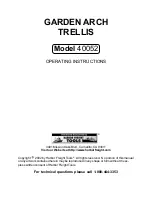
FXAlg #733: Rotor 2 ¥ FXAlg #734: Rotor 4
Algorithm Reference-107
Rotating speaker with virtual microphones
For the rotating speakers, you can control the crossover frequency of the high and low frequency bands (the
frequency where the high and low frequencies get separated). The rotating speakers for the high and low
frequencies have their own controls. For both, the rotation rate, the effective driver size and tremolo can be set. The
rotation rate sets how fast the rotating speaker is spinning. The effective driver size is the radius of the path followed
by the speaker relative to its center of rotation. This parameter is used to calculate the resulting Doppler shift of the
moving speaker. Doppler shift is the pitch shift that occurs when a sound source moves toward or away from you
the listener. In a rotating speaker, the Doppler shift will sound like vibrato. As well as Doppler shift, there will be
some acoustic shadowing as the speaker is alternately pointed away from you and toward you. The shadowing is
simulated with a tremolo over which you can control the tremolo depth and ÒwidthÓ. The high-frequency driver
(rotating horn) will have a narrower acoustic beam width (dispersion) than the low-frequency driver, and the
widths of both may be adjusted. Note that it can take up to one full speaker rotation before you hear changes to
tremolo when parameter values are changed. Negative microphone angles take a longer time to respond to tremolo
changes than positive microphone angles.
Acoustic beams for (i) low frequency driver and (ii) high frequency driver.
You can control resonant modes within the rotating speaker cabinet with the Lo and Hi Resonate parameters. For
a realistic rotating speaker, the resonance level and delay excursion should be set quite low. High levels will give
wild pitch shifting.
negative angles
positive angles
(i)
(ii)















































